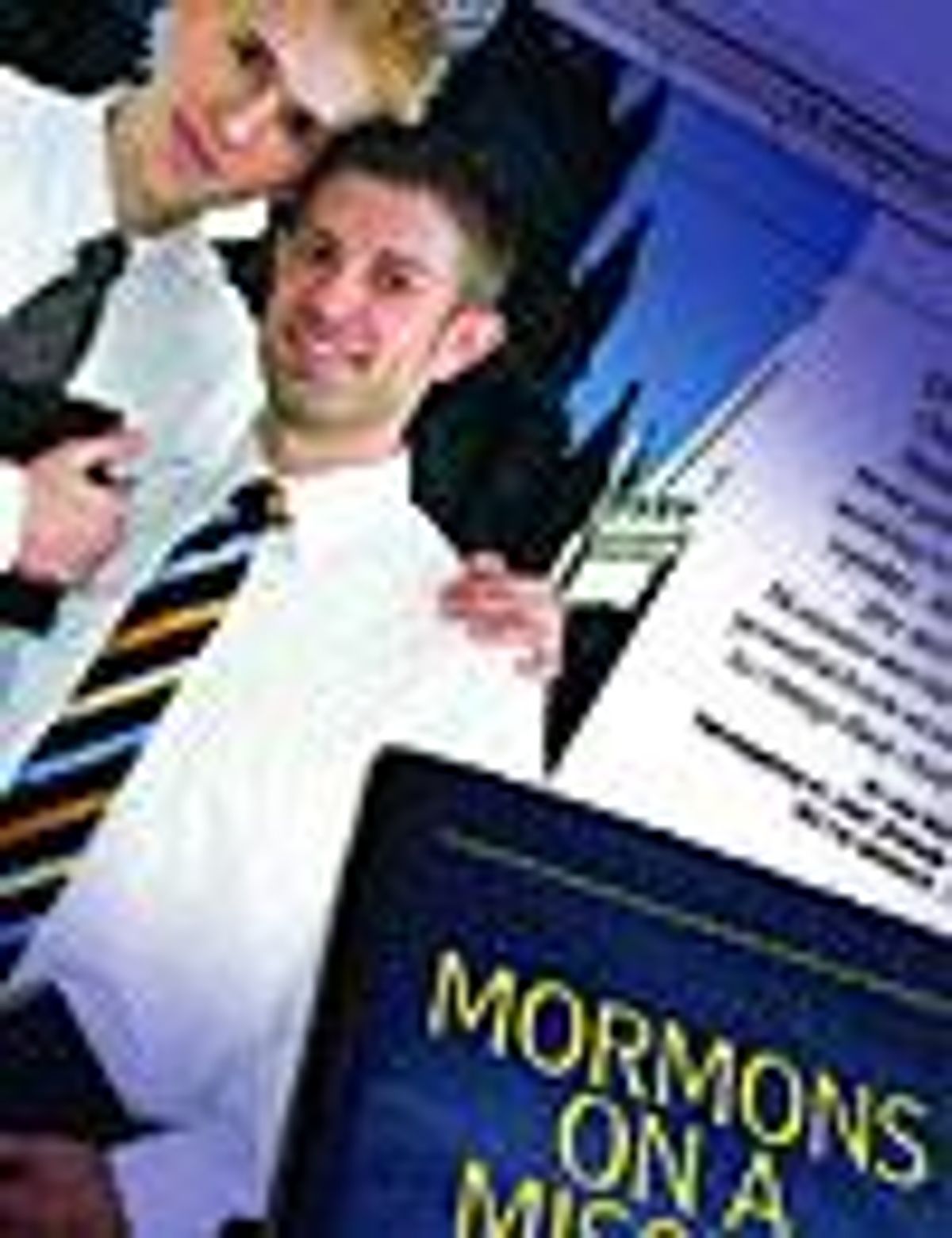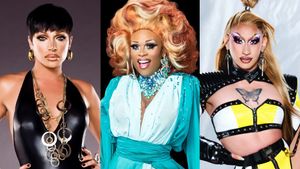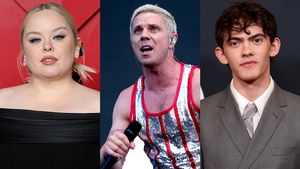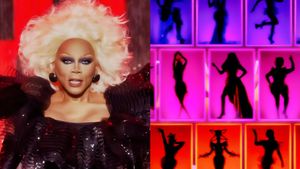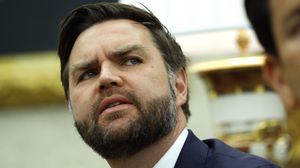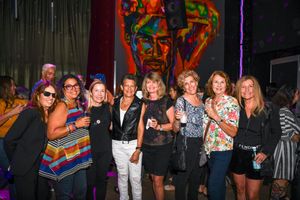Struggling with
his gay sexual orientation several years ago, Aaron
Cloward sought help from the leaders of his local Church of
Jesus Christ of Latter-day Saints. He didn't
get any. "The last [Mormon] bishop I talked to
said, 'You are rejecting Christ. You are on the
pathway to hell,' " says Cloward.
"The way that makes you feel--"
He considered suicide.
"I walked home and got my boxes of
Benadryl," remembers Cloward, now a 28-year-old
surgical technician who lives in Salt Lake City.
"Fortunately I had the presence of mind to call my
mom. She came over and held me as I cried myself to
sleep. It made me take a step back and look at the
church with a critical eye."
Cloward, who served on a church mission to
Southern California, quickly left behind the church
and its antigay doctrine, which says that its
followers can go forward in the religion only if they do not
act on their same-sex attraction. He started a support
group in Salt Lake City called Gay LDS Young Adults in
the hope of helping other gay and lesbian Mormons find
comfort and acceptance as they struggle with the
church's teachings and long-held traditions.
Last year, Cloward stood on a downtown Salt Lake
City street corner during Utah's battle over a
constitutional amendment banning gay marriage. He
handed out fliers and carried picket signs urging passersby
to vote contrary to the church and defeat the amendment.
"People will say, 'No, no, the church
doesn't tell me how to
vote,' " says Cloward. "But I will
say that in church I did hear the message:
'These are the values we stand for. Vote accordingly.' "
What has become clear to Cloward and tens of
thousands of other GLBT Mormons is the harsh fact that
although they may have left the church, the church
won't stop meddling in their lives. While the Roman
Catholic Church and the Southern Baptist Convention have
grabbed the most headlines with calls to "save
traditional marriage," the Mormon Church has
quietly become one of the most powerful forces opposing
any changes that offer gays and lesbians equality under the
law. Not only does it lean heavily on its members to
deny their homosexuality and to vote for candidates
and ballot measures opposing equality, it's
thought to be spending millions of dollars to support
antigay initiatives and politicians.
The church becomes more powerful every year.
With about 5.5 million members in the United States
and nearly 12 million worldwide, the Mormon Church is
one of the world's fastest-growing
denominations--and one of the wealthiest. Some
estimates put its net worth at close to $30 billion,
although church leaders dispute that figure.
The LDS Church is a formidable opponent of gay
equality. It's also quite a force to reckon
with if you're young and queer and growing up Mormon.
The lives of many gay and lesbian Mormons indeed
reflect the emotional messiness portrayed in the 2003
indie movie Latter Days. In that film,
19-year-old Aaron "Elder" Davis is sent
to Southern California--as was Cloward--on a
proselytizing mission, a service expected of all young
male (and some female) Mormons. On his own for the
first time, Aaron begins to realize he's gay and
falls in love with a hunky West Hollywood gay man named
Christian. After they spend one night together, Aaron
freaks out and flees home to his aghast family,
including an LDS-bishop father who recommends
"reparative therapy" for his wayward son.
"God hates homos," one of the other
missionaries declares.
When John Hales, 33, of Manti, Utah, served as a
missionary in Winnipeg, Canada, in the early 1990s, he
had already been struggling with his same-sex
attractions for some time. "I thought it was a
spiritual weakness," he says. I thought, I
can overcome this as soon as I find the right
woman." He worked hard to conquer his
"weakness" and planned to devote his life
and career to teaching church ways. "When I realized
that if I did marry, I wouldn't be able to
fulfill a woman's needs emotionally,
that's when I made the decision to come out,"
he says. "It was one thing to sacrifice my own
desires or happiness, but I realized it
wouldn't be fair to a mate."
Hales, now a journalist, was born into the
church, his family's ancestry dating back to
hard-living pioneer times and the dawn of the
Latter-day Saints.
Founded by Joseph Smith in upstate New York in
1830, the early LDS Church faced prejudice and
persecution. Its founder and members fled westward,
first to Illinois, where Smith was killed by vigilantes,
then to the Utah Territory under the leadership of
Brigham Young. It was a disciplined mass migration by
wagon, handcart, and horseback, with the adherents
eventually taking refuge in the region on the shores of the
Great Salt Lake.
The long journey, the hard times, and the
struggle produced a membership proud of its pioneer
heritage. "I have relatives who came across the
plains," says lesbian Mormon Sara Jordan, 42, a
writer and documentary filmmaker from Salt Lake City.
"So it's in my DNA. I have direct
ancestry to immigrants who came from England and the
Nordic region to join the church soon after the church was established."
Held together by filial bonds and the largest
possible families--something made easier to
produce by the church's early embrace of
polygamy, a practice officially abandoned in 1890 but
still practiced by many breakaway LDS sects--the
church's emphasis on strong families is its
core value. "It's a wonderful world to
grow up in," says gay actor Steven Fales, 34, a
Salt Lake City native. "It is not just a religion. It
is a worldview, a world community, a
family."Cloward also claims "direct
pioneer ancestry." He grew up in Mount Pleasant, the
geographic center of Utah, population 2,000. Both he and
Fales knew at an early age they'd serve as
missionaries. "From the earliest age you are
indoctrinated," Fales says. "You grow up
saving for your mission, putting pennies in a jar."
To become missionaries, Mormon youths must prove
their worthiness and undergo intensive studies in
language and scripture, both the Judeo-Christian Bible
and the church's own Book of Mormon. From the
central training center--the U.S. facility is in
Provo, Utah--young Mormons embark on an unpaid
two-year term of service. Some 60,000 missionaries
serve throughout the world, putting in long,
regimented days calling on prospective converts.
Missionaries travel and live in same-sex groups of two
to four, but still they remain isolated--young
men and women in unfamiliar locations, separated from
friends and family, calling home just twice a year, on
Mother's Day and Christmas.
"You can't help but experience
miracles," says Nate Currey, who served two
years as a missionary in Vilnius, Lithuania. Currey,
who grew up in Denver, was a teenage convert to the LDS
Church, attracted to the spirituality, the structure,
and the fellowship. He struggled through adolescence
and young adulthood to understand and adhere to the
church's "love the sinner, hate the
sin" approach to homosexuality. "I
thought if I was out there [on my mission] doing my
best, doing what God expected me to do, being obedient
and following the rules, that this attraction would go
away," he says. "But I saw eventually
that it wouldn't."
Currey had his first gay experience while on his
mission. "It's not something that
I'm proud of," he says.
"That's not the reason that I was there, and
it is probably one of the true regrets that I have in
my life." Church authorities found out. Just
weeks after Currey completed his missionary work and
enrolled at the LDS-operated Brigham Young University, he
was called before a panel of 16 church leaders who
inquired in explicit detail about his homosexual
activity--with whom and how many times. "I was
emotionally drained--fried," he says about the experience.
Ousted from the church, Currey went home to
Denver to deliver his parents a triple whammy:
"I've been kicked out of the church, I
withdrew from school, and, by the way, I'm
gay." It was more traumatic for him than for
his family, Currey says: For a while he
couldn't pass a church without breaking into tears.
As Fales puts it, Currey had "lost his
smile"--his optimistic, Osmond-like LDS
outlook on life.
But Currey, now 26, found a new smile. He got
married last May--but the union took place at
Toronto City Hall, not in an LDS temple, and he
married a Mormon man, not a Mormon woman. "We just
did it with a justice of the peace," says
Currey, who lives with his partner in a college town
in northern Utah. "Back here we had a
reception--my family, his family. You could feel the
love. And I knew then I could be happy and have a
fulfilling life in Logan, Utah."
Currey still cherishes his Mormon identity. He
expresses respect for the church, a love for its
people, a belief in its God. "It's been
good for me to come back to the state where I was
excommunicated, to come back to succeed, to be happy,
to find a partner and have a good life--a super
life," he says.
The LDS Church projects a powerful image of
comfort, family, and mutual support--it's
one of the chief selling points young missionaries use
to win recruits to the Mormon lifestyle. A pro-LDS Web
site, FamilyForever.com, promotes the church's belief
in a family-centered afterlife with the slogan
"Families Can Be Together Forever!" With
so much riding on a warm and loving public perception,
it's easy to see why the church is hesitant to
trumpet its rabid opposition to equality for gays and
lesbians. Just as a panel of elders--led by his
own furiously angry father--confronts Aaron in
an atmosphere of secrecy in Latter Days, the
church itself keeps its antigay activism largely under wraps.
While other religions have leaders who
constantly preach against gay equality and warn of
damnation and social collapse if they're
opposed--say, the Reverend Jerry Falwell or Pope John
Paul II--the Church of Jesus Christ has
94-year-old president Gordon B. Hinckley. Also known
as the church's chief "prophet, seer,
and revelator," since receiving messages directly
from God is part of his job description, Hinckley is
an unassuming, grandfatherly figure who makes the
occasional appearance on such shows as CNN's Larry
King Live to try to gently dispel stereotypes about the
Mormon faith.
"You will not see Mormon [Church] leaders
go in front of legislators," says Olin Thomas,
executive director of Affirmation, a growing
international network of gay and lesbian Mormons.
"But they will suggest members act
individually. It's somewhat low-key."
Massachusetts governor Mitt Romney--who is doing
everything he can to stop his state's legal same-sex
marriages and even opposes civil unions--rarely
discusses the fact that he is a member of the LDS
Church. Ditto Utah's powerful U.S. senator Orrin Hatch.
Low-key action doesn't yield low returns.
It only takes a gentle reminder--a statement
from LDS headquarters, a few words at Sunday service,
a church bulletin--criticizing same-sex marriage to
yield Election Day votes and big money for antigay
groups. Excommunicated Mormon and LDS scholar D.
Michael Quinn of Los Angeles has likened church
members following LDS leaders' instructions to an
army of ants taking orders from above. "The
organizing power of the church is kind of like the
military, and it has political clout far in excess of
its actual size," Quinn says.
The church began spending money to fight gay
marriage in the 1990s, when Hawaii was expected to
become the first state to legally wed same-sex
couples. In 1998 the church invested an estimated $600,000
in the campaign to ban same-sex marriage in Hawaii as
well as $500,000 in Alaska, the site of another major
marriage dispute.
"They were right up there as one of the
leading funders and leading instigators of antigay
attacks in Hawaii. And then there was
California," says Evan Wolfson, the founder of
Freedom to Marry and, when he was with Lambda Legal,
an attorney in the Hawaii lawsuit that sparked a
national dialogue on marriage.
By the end of 2006 as many as 15
states--including New Mexico, Arizona, Alabama,
Iowa, Kansas, South Carolina, South Dakota, Texas,
Virginia, Tennessee, and of course Massachusetts--are
expected to debate constitutional amendments outlawing
same-sex marriage. LDS spokeswoman Kim Farah tells The
Advocate, "There are no efforts under way for
or against these proposed amendments" and that the
church was not actively involved in the 2004 ballot
initiatives outlawing same-sex marriage that passed in
11 states in November.
That's not strictly true. In the midst of
the state ballot battles, the office of the LDS First
Presidency--Hinckley's office, charged
with relating God's own messages--issued a
brief statement in July 2004 about President
Bush's push for an antigay federal amendment:
"The Church of Jesus Christ of Latter-day Saints
favors a constitutional amendment preserving marriage as the
lawful union of a man and a woman." Three
months later, on October 19, the church issued another
statement: "As a doctrinal principle, based on
sacred scripture, we affirm that marriage between a man and
a woman is essential to the Creator's plan for
the eternal destiny of his children. The powers of
procreation are to be exercised only between a man and
a woman lawfully wedded as husband and wife. Any other
sexual relations, including those between persons of
the same gender, undermine the divinely created
institution of the family."
Less than a month later, voters in Arkansas,
Georgia, Kentucky, Michigan, Mississippi, Montana,
North Dakota, Ohio, Oklahoma, Oregon, and Utah
approved constitutional amendments banning same-sex marriage.
"The church is an incredibly private
organization. There's no annual report.
You'll never know how much money they have or where
it is going," says Michael Mitchell, executive
director of Equality Utah, a gay rights group.
"But the church came out with the statement and
the voters responded."
Gay rights advocates in the new battleground
states who are familiar with the church's
tactics anticipate that LDS leaders will get involved
in their fights--perhaps, as in 2004, late and without warning.
"We know they have been involved in
initiatives in other states and that they tend to get
involved later in the game," says Steve May, a
former state lawmaker and cochair of the Arizona Human
Rights Fund. May is a former LDS Church member, whom
the Army Reserves tried to expel because he's gay.
Arizona lies in the Mormon Belt, which stretches
across the vast American West from the Colorado
Rockies to the Pacific Ocean, reaching up into the
Canadian prairie provinces and down into Mexico. It's
in this belt --especially Utah, the big
buckle--that Mormons are most influential in
U.S. politics. "The church has significant numbers
there," says Affirmation's Thomas.
"They can sway a close election."
The church's strategy and motivation in
fighting against gay and lesbian equality appears to
be modeled on its campaign against the Equal Rights
Amendment in the 1970s, the passage of which the church said
would result in "encouragement of those who
seek a unisex society, an increase in the practice of
homosexual and lesbian activities, and other concepts
which could alter the natural, God-given relationship of men
and women."
The church
employed an effective top-down chain of command in that
battle, from headquarters to church leaders in 20 states,
and that remains the approach in the LDS fight to
support antigay discrimination, says Mormon scholar
Quinn. "The organizing power of the church is
such that it can produce incredible numbers in states, even
where it only has 1% or so of the population."
Even where its voters are far outnumbered, the
church may still exercise the power of the purse.
During the 2000 fight over Proposition 22, the ballot
measure to outlaw same-sex marriage in California, church
leaders urged members to donate money and volunteer. A
letter from one church leader, Douglas L. Callister,
outlined the LDS strategy: Participation was
voluntary, he wrote, but "this is a moral issue,
rather than political." Solicitation of funds,
he added, should begin with more affluent members, and
"many of these members will be asked to provide
telephone and other grassroots efforts near election time."
Timothy Cavanaugh, development director for
Equality California, served as finance director in the
unsuccessful campaign to defeat Proposition 22. He
recalls, "On Sundays, in church bulletins and
publications, it was a high priority to get Mormons to
work to ensure that the ballot initiative passed. It
was preached from the pulpit. And there were huge
amounts of money."
The considerable LDS effort on Proposition 22
prompted gay state legislator Mark Leno of San
Francisco to call for an investigation into the
church's tax-exempt status with the IRS.
It also proved so painful for one gay Mormon
that he committed suicide. Stuart Matis, 32, shot
himself in a walkway behind an LDS church building,
leaving a suicide note saying, "I am now free. I am
no longer in pain and I no longer hate myself. As it
turns out, God never intended for me to be straight.
Perhaps my death might be the catalyst for some good."
Official church policy on homosexuality is best
expressed by President Hinckley, who at a General
Conference of the church in 1998 said, "People
inquire about our position on those who consider themselves
so-called gays and lesbians. My response is that we love
them as sons and daughters of God. They may have
certain inclinations which are powerful and which may
be difficult to control.... If they do not act upon
these inclinations, then they can go forward as do all other
members of the church. If they violate the law of
chastity and the moral standards of the church, then
they are subject to the discipline of the church, just
as others are." Hinckley did not go on to explain
that God's punishment for a sin as grievous as
homosexuality would likely be fiery damnation for all
eternity. That would not have been grandfatherly.
To avoid exile from the mother church on earth
and hellfire in the afterlife, many gay Mormons have
been encouraged by their church to undergo various
forms of "ex-gay" therapy. Some join the
LDS-backed Evergreen International, a program that
encourages people to "turn away" from
homosexuality; some undergo shock treatments.
Such therapy did not work for Steven Fales. He
struggled with being gay throughout a two-year mission
to Portugal, graduation from BYU, marriage to a Mormon
woman, and fathering two kids. In the end, he got divorced,
was excommunicated, and, he says, "threw God
out" of his life. He turned briefly to a life
of prostitution and drugs, then to theater, writing,
and performing an autobiographical one-man show titled
Confessions of a Mormon Boy.
A downward spiral after coming out is not
unusual. Sudden separation from the regimented and
pervasive support structure the church's focus
on the family encourages can leave gay and lesbian Mormons
feeling intense isolation and shame. Many have
committed suicide rather than face life outside the
church. To counteract that emotional trauma, gay and
lesbian Mormons have formed several pro-gay support groups,
including Cloward's Gay LDS Young Adults in
Salt Lake City, Family Fellowship, and Affirmation,
which has chapters throughout the country. Some in
these groups seek to make peace with the church. Some seek
to change the church. Many seek both.
"My heritage is a vital part of
me," says writer and filmmaker Jordan.
"I embrace that. But it's not all of who I
am. As I process what going back to church means, I know
that church culture is such that, as a lesbian, I
would have to leave an essential part of who I am at
the door. And I won't." Still, she adds,
"I don't believe that the Christ that I have
come to know and love would ask me to make that choice."
Affirmation leader Thomas is optimistic about
the church's evolution. "The Mormon
Church has a long history of being a generation behind
society," Thomas says. "Really, at this
point, no mainstream church is embracing gays. And the
Mormon Church will be behind the mainstream churches,
just as it was on the race issue. It will wait for the
dust to settle."
Utah activist Mitchell sees signs that some
voters are wriggling out from under the
church's thumb. He points out that the state's
2004 constitutional amendment to outlaw same-sex
marriage received about 66% of the vote--not as
low as the 58% in Oregon and the 59% in Michigan, but
not as high as the 86% in Mississippi.
"That's surprising," he
says. "Everyone assumed we would lose by an
80-20 spread. But we ran a good campaign. We
got our Mormon attorney general to come out against the
amendment. So, while the church has been in the way,
there is change."
The most important place to fight for change may
be at the very the heart of Mormonism: within each
family. Aaron Cloward's boyfriend of several
years, Stephen Shroy, started attending LDS services at age
6, in Central Point, Ore., and stopped when he came
out three years ago. "My family is very
LDS," he says. "So it's still
hard for my parents--though it has gotten a lot
better. From their point of view, I've made
choices that preclude me from being with them through
all eternity. I used to very strongly believe that. Now I
don't believe that God would keep a family apart."
Cloward has had a somewhat easier time.
"Most [of my family] are no longer active in
the church for their own various reasons," he
says, adding that his mother is a lesbian and that he, in
fact, had encouraged her to change her sexuality.
"I thought being gay was a horrible spiritual
problem, and I thought I needed to change my
orientation," Cloward says. "So I went through
the Mormon ministry for reparative therapy and
reorientation [and] I was also trying to get [my
mother] to change her orientation. Eventually, though, as I
finally came to accept myself, I came out to her and barely
got the words out before a river of tears came and I
bawled like a baby."
For some younger Mormons, coming out does not
mean abandoning their heritage. Brent Brazelton, a
21-year-old English major at Wright State University
in Dayton, Ohio, did missionary work in Taiwan for nine
months. But he cut his service short, returning home with a
tremendous sense of shame but also relief. "I
realized I was no less gay than when I left,"
he says. "I had come to terms with it and went
home early." His mission president, who
"threatened fire and brimstone," was
displeased, but Brazelton has been embraced by his
family. After attending church for several months after
returning from Taiwan, Brazelton became inactive,
returning to services only on holidays, if at all.
Nevertheless, he says, "I'm
culturally a Mormon. That means you don't
drink, you don't smoke, and you joke about Jell-O.
I still live the lifestyle, aside from my boyfriend."
